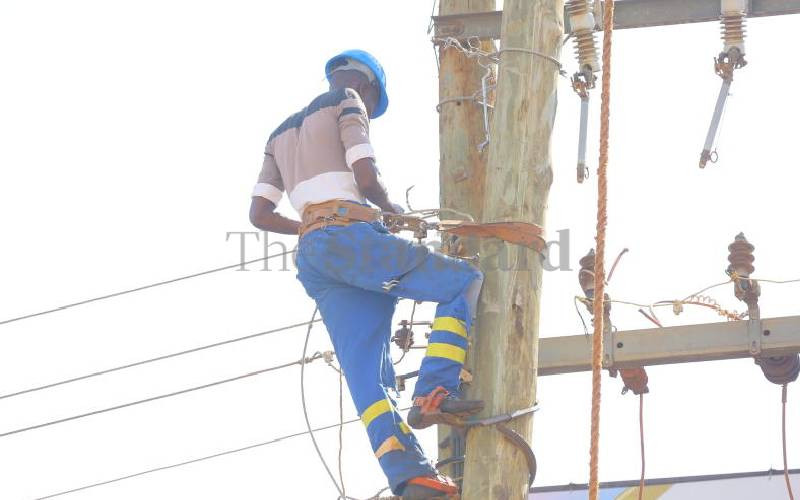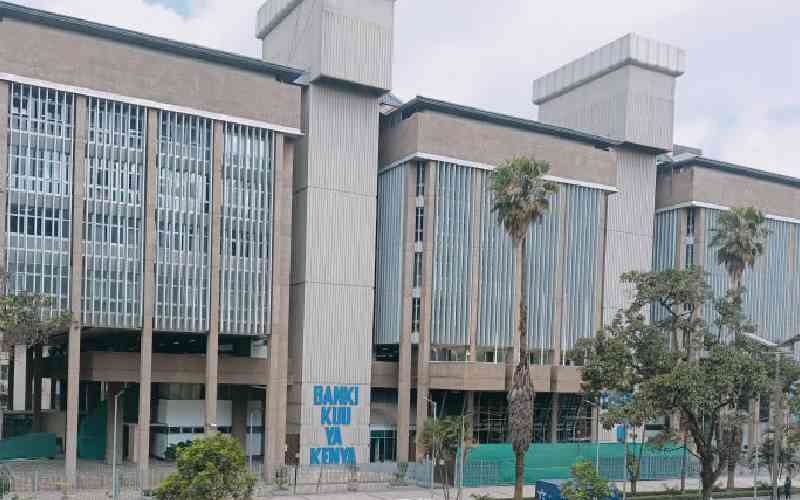
It is almost nine years since Mary (not her real name) took a Sh20,000 loan from the Kenya Women Microfinance Bank (KWFT).
All this time, the 30-year-old mother of two has not been servicing the loan and is not about to start any time soon.
“I didn’t want the loan in the first place,” says Mary.
She insists she was bundled into a women’s group, which she learnt later, wanted to borrow money.
She does not know exactly what she did with the money, but she is certain starting a business never crossed her mind. However, she remembers treating her family to a sumptuous meal of chicken and chapatis on the night she received the money.
One of the conditions for getting the loan was having a business and assets. Mary did not have either. She had just finished secondary school.
But when they insisted, she simply directed the credit officers to her cousin’s grocery business.
And after an extended cat-and-mouse game with the credit officers in a bid to recover the money, they stopped.
Later, the bank would bombard her with text messages, warning they would list her at the credit reference bureaus (CRBs) after which she would be barred from getting a loan from any other institution. But these threats also fizzled out.
Mary was one of the easy targets for the myriad microfinance institutions which, at the turn of the 21st century, aggressively waded into the unchartered waters of lending to residents of rural areas and slums, places that commercial banks had hitherto avoided.

They left in their wake a social crisis in these areas while inheriting a financial crisis that they are still reeling from to this day. By now Mary’s loan should as well have been written off by the regulated entities, such as microfinance banks (MFBs) as part of the requirement by Central Bank of Kenya’s (CBK) Prudential Guidelines.
Although Mary walks around unscathed, there are hundreds of thousands of other poor women and youth who were driven further into poverty after the microlenders sold their household assets, crops, and livestock.
The remaining unregulated microfinance institutions (MFIs) are licking their wounds after a bruising fight that has been compounded by digital lenders taking their predatory lending to another level. For three consecutive years to 2019, the 13 MFBs have been bleeding cash as customers reduce to a trickle and default rates surge.
The non-performing loans (Npls) - loans that have not been serviced for more than three months - have risen sharply between 2011 and 2019.
For every Sh100 that MFBs had lent out in 2019, Sh21 ended up being bad loans. For commercial banks, only Sh12 were non-performing.
While MFBs, just like the small banks, target risky borrowers and hence their NPLS are expected to be higher than those of commercial banks, the divergence was not that significant in 2012, although there were only six such institutions.
Nine years ago, there was Sh7-worth of NPLS for every Sh100 that the micro-lenders had given out in loans. The fraction of bad loans for commercial banks at the time stood at Sh5.
It is the same with KWFT, an MFB with the largest market size. Its ratio of NPLS to gross loans grew to 21.1 per cent two years ago from 6.4 per cent in 2012.
By the end of 2019, the 13 regulated microfinance banks cut their losses to Sh309 million from Sh1.4 billion a year earlier.
MFBs that made the most profits included Faulu Microfinance Bank (Sh312 million), SMEP (Sh6 million), Sumac Microfinance (Sh9 million), and U&I (Sh4 million). This was the third consecutive year that MFBs were stuck in the loss-making zone.
MFIs that registered losses include Rafiki that recorded Sh3 million loss, Caritas (Sh51 million), KEYC (Sh31 million), Uwezo (Sh31 million), Daraja (Sh32 million), Maisha (Sh38 million), Century (Sh43 million) and Choice (Sh29 million).
“It (microfinance) is a business model, which is getting phased out,” said Joy Kiiru, an Economics lecturer at the University of Nairobi who has also done several papers on the microfinance sector.

Besides physical collateral, the microlenders also used what is known as social collateral where the members guarantee each other. If one member does not pay, even once, others lose all their savings.
As such, it is upon each member to coerce the delinquent member to pay up.
But where did it all go wrong? According to Dr Kiiru, the period between 2008 and 2010 when she did her studies, things were looking up, with the repayment rate at between 97 per cent and 98 per cent.
“It was very impressive, better than the commercial banking,” she said.
Unfortunately, these groups increasingly started having members like Mary, who was not even acquainted with the rest of the members and had not planned on how to spend the loan money.
Scholastic Odhiambo, an Economics lecturer at Maseno University, said although social collateral resulted in increased lending, it might not have been effective in reducing the stock of bad loans. “They have quite a number of high-risk borrowers who even when guaranteed by the group, it may not work,” said Dr Odhiambo.
Suddenly, there was an uproar in slums and villages. Members, especially women who were punctilious in repaying their loans, felt slighted for being forced to repay for errant members. Fights ensued. The high repayment rates were not happening because people were well off to repay; it was as a result of the lenders resorting to aggressive loan recovery techniques, some bordering on criminal acts.
“Loans were not getting paid because people were doing very well. People were paying because they really had to. There is no other route,” recalled Kiiru.
The low-lying fruits were women, the youth and rural residents, with most of the MFIs, which received cheap money from International Financial Institutions (IFIs), packaging their products within the broader social goals of women empowerment and poverty alleviation.
If the equivalent of the 2008 financial crisis was to occur in Kenya, it would have started in the microfinance sector, which was rife with predatory lending. “When I was in the field, I saw loan officers helping women to fake information,” remembered Kiiru.
Because the loans were meant for enterprise development, a woman who had no business joined up with one who did.
“And the loan officer is there, pretending that they do not know that this business is not hers,” she explained.
It was all about the loan officer trying to hit their targets, rather than ensuring that the loans they gave out would be repaid, a dangerous moral hazard that is cited as one of the main causes of the global financial crisis of 2008.
“It actually exposes the whole economy because at the end of the day, when there are mass defaults then the banks are unable to meet their short-term liquidity obligations,” says Kiiru.
“When bank managers give loan officers unrealistic targets, you see, people think about survival first.”
The hawking of loans has since abated as the supervision of banks has been tightened.
Microfinance was perfected by the Nobel Peace Prize winner Muhammad Yunus.
His ingenious efforts, according to the Norwegian Committee, helped the poor break free of the poverty cycle.
Unfortunately, his noble intention has in some instances, gone rogue and wiped out all traces of happiness from the faces of hundreds of thousands of poor people.
Bangladesh Prime Minister Sheik Hasina went on to describe Mr Yunus and his microfinance institution (MFI) Grameen Bank as “sucking blood from the poor in the name of poverty alleviation.” In India’s state of Andhra Pradesh, for example, The Guardian newspaper reported how in 2011 aggressive selling techniques, high-interest rates, and aggressive collection of loan repayments by MFIs left some rural folks poorer than before.
Not that things have changed a lot in the sub-sector. A financial analyst, who wanted to remain anonymous due to the nature of his work, said although the three big MFBs have hired audit firms like Deloitte and PWC to better their risks, they are yet to hear of serious bank-type risk scoring or pricing models.
“From what I know, they use very little credit scoring models or market risk management,” said the source, noting that because most of the loans are mostly check-off loans, their only risk management may include confirming whether the documentation is correct.
Later on, while some of the MFIs were assimilated into the banking industry, with the micro-lending products being retained, according to Odhiambo, the enactment of interest rates also dealt a blow to this model of business. The capping of the cost of loans in 2016 found a market that was already shaky, as interest rates were capped below the cost of capital.
“And that gave an opportunity for digital lending to start forming because there was excess demand for credit,” said Kiiru.
Although the ceiling made the loans from commercial banks cheaper, they were not enough to satisfy all the demand.
“So the digital lending platforms came up all of a sudden,” she explained.
As the name suggests, a microfinance institution is a small lending institution.
By the end of 2019, all the MFBs had just 25,017 accounts with more than Sh100,000. This was just a tenth of the accounts with more than Sh100,000 at the KCB Bank.
It was very easy for mobile lending platforms - some with superior credit rating tools such as KCB-MPesa and Mshwari.
Consequently, the predatory lending, already entrenched by MFIs, shifted to the new digital lending platforms.
Now, MFBs, with tighter regulations from CBK, are competing with digital lenders with a very minimum cost of running businesses.
“The people they were targeting are still there, but there are so many other outlets,” said Kiiru.
Even worse is that unlike MFIs where the majority of the borrowers (41 per cent) used their loans to buy assets, such as machinery or a water-tank, most mobile banking loans (57.6 per cent) were used to expand a business, according to a survey by CBK, the Kenya Bureau of Statistics and Financial Sector Deepening (FSD).
 The Standard Group Plc is a multi-media organization with investments in media
platforms spanning newspaper print operations, television, radio broadcasting,
digital and online services. The Standard Group is recognized as a leading
multi-media house in Kenya with a key influence in matters of national and
international interest.
The Standard Group Plc is a multi-media organization with investments in media
platforms spanning newspaper print operations, television, radio broadcasting,
digital and online services. The Standard Group is recognized as a leading
multi-media house in Kenya with a key influence in matters of national and
international interest.
 The Standard Group Plc is a multi-media organization with investments in media
platforms spanning newspaper print operations, television, radio broadcasting,
digital and online services. The Standard Group is recognized as a leading
multi-media house in Kenya with a key influence in matters of national and
international interest.
The Standard Group Plc is a multi-media organization with investments in media
platforms spanning newspaper print operations, television, radio broadcasting,
digital and online services. The Standard Group is recognized as a leading
multi-media house in Kenya with a key influence in matters of national and
international interest.












